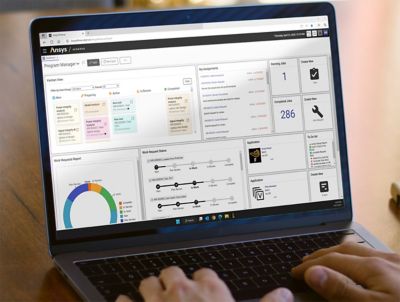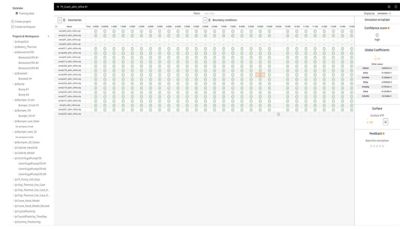-
United States -
United Kingdom -
India -
France -
Deutschland -
Italia -
日本 -
대한민국 -
中国 -
台灣
-
Ansys는 학생들에게 시뮬레이션 엔지니어링 소프트웨어를 무료로 제공함으로써 오늘날의 학생들의 성장을 지속적으로 지원하고 있습니다.
-
Ansys는 학생들에게 시뮬레이션 엔지니어링 소프트웨어를 무료로 제공함으로써 오늘날의 학생들의 성장을 지속적으로 지원하고 있습니다.
-
Ansys는 학생들에게 시뮬레이션 엔지니어링 소프트웨어를 무료로 제공함으로써 오늘날의 학생들의 성장을 지속적으로 지원하고 있습니다.
ANSYS BLOG
April 12, 2024
A Winning Team: Leverage SPDM to Enhance AI Training
Despite the inference drawn from its name, artificial intelligence (AI) is based on very real data. In fact, data is fundamental to AI training. Typically, an engineer feeds an AI model with data to train it to perform tasks. As you might imagine, data accuracy is essential for successful AI training, which generally requires a large volume of data. In this regard, simulation offers significant support, including predictive accuracy, a large capacity for data, near-limitless analysis capabilities, and speedy results.
Ansys’ latest AI-based technology, Ansys SimAI, is a physics-agnostic, cloud-native software as a service (SaaS) application that combines the predictive accuracy of Ansys simulation with the speed of generative AI. Customers can train the AI using previously generated Ansys or non-Ansys data. For simulation and process data management (SPDM) users, such as Ansys Minerva customers, this is great news. In SPDM platforms, an abundance of data is already organized, managed, and ready to go. This makes it even easier, faster, and more efficient to supply data to SimAI. Let’s explore how you can leverage SPDM to enhance AI training.

Well-maintained files and information from simulation process and data management (SPDM) systems like Ansys Minerva provide copious and valuable data for artificial intelligence (AI) training.
Understand the Players
SPDM enables teams to manage simulation, data, workflows, and resources throughout their organization, spanning various departments and engineering disciplines, from one central database. With an SPDM solution such as Minerva, companies can create a digital thread throughout all stages of the product life cycle, increasing productivity, design success, and collaboration.
What does this have to do with SimAI? In relation to AI training, it means Minerva users have quick and easy access to well-organized, robust data from every corner of their organization.
Now, let’s get to know SimAI a bit better. Designed for users without coding experience or deep learning expertise, the application is intuitive and easy to use. Instead of relying on geometric parameters to define a design, SimAI uses the shape of a design itself as the input, facilitating broader design exploration even if the shape’s structure is inconsistent across the training data. In addition, the application can boost the prediction of model performance throughout all design phases by 10-100X for computation-heavy projects. Training and predictions are hosted on a state-of-the-art cloud infrastructure to ensure that user data is secure.
Essentially, SimAI is engaged in three simple steps: upload data, train AI model, and predict. As mentioned, customers can train the AI using previously generated Ansys or non-Ansys data. This gives SPDM users a generous advantage because their data is already compiled, sorted, and accessible in a few clicks.

Ansys SimAI boosts the prediction of model performance across all design phases by 10-100X for computation-heavy projects — delivering simulation results in minutes, not hours.
Enhance the Power of AI with SPDM
So, how do we move our Minerva data into SimAI? First, you can connect with SimAI using a web application directly through your browser. Next, from Minerva, select the files you wish to use and drag them over to a dedicated folder in your file system. Run a script in this folder to convert the simulation data into a Visualization Tool Kit (VTK) file, an open-source format that SimAI can understand. Then drag the files from your local file system into the SimAI web application and you’re all set.
In SimAI, you can now configure a model using your data and initiate AI training. You can even assess the quality of your data by using an existing SimAI model to evaluate the performance of geometry within your computer-aided design (CAD) files, then automatically download the results into Minerva.
Conveniently, with SimAI’s cloud-first approach, your original results for training are stored on remote servers. This eliminates unnecessary uploading or downloading between local and remote file systems as you continue to train your AI.
SimAI relies on simulation results to undertake the learning and training needed to complete tasks or generate design recommendations. For this reason, it is critical to keep track of simulation results when preparing to train AI — something that Minerva does inherently. But the benefits of SPDM don’t stop at the onset of training.
As you continue to train your AI and run more simulations, you will create even more results that need to be categorized, organized, and managed so that SimAI can learn and make even better recommendations. In this way, Minerva provides continuous support throughout AI training — which is often an ongoing, evolving process. Similarly, in SimAI, you can tag your prediction results with metadata, including global coefficients or values like lift and drag, making your results easier to locate later.

Connect with SimAI using a web application directly through your browser.
Make the Tools Work for You
We’ve already established that SPDM is a secure repository for simulation results that are categorized, organized, and easy to find, but Minerva also stores important information about these results so users can understand them better. This insight encourages better decision-making when selecting data input for SimAI, accelerates the AI training process, and makes it more efficient.
Other advantages are that Minerva supports cloud deployment and offers native interoperability with all popular CAD and computer-aided engineering (CAE) tools, as well as product life cycle management (PLM) systems. It also integrates easily with other Ansys Connect family products, including Ansys Granta MI Enterprise materials management, Ansys optiSLang process integration and design optimization, and Ansys ModelCenter model-based systems engineering (MBSE) software. This means that your Minerva data is likely chock-full of insights from a variety of Ansys and non-Ansys solutions, ready to provide comprehensive training to your AI model. In addition, a multiphysics simulation workflow works seamlessly with SimAI, a physics-neutral application. As a result, customers can leverage Minerva and SimAI across all engineering disciplines, simulation products, and industry segments.
Learn More About Ansys AI Solutions
Operating at extreme speeds, Ansys’ latest AI solution accelerates research and development, shortens product development cycles, and promotes human creativity by enabling expansive design exploration.
SPDM solutions like Minerva expand upon these capabilities and enhance the power of AI through optimized, targeted training comprised of comprehensive and accurate data.
To learn more about AI-powered innovations at Ansys visit Ansys AI — AI-Augmented Simulation Technology. To discover how an SPDM solution can benefit your team, request a free assessment for Minerva.










